
‘Tis the season of giving, and particularly, giving back. Unfortunately, hunger remains a pressing issue in Western Washington. Every day, far too many individuals and families don’t know where they’ll find their next meal. Luckily, Seattle is home to more than a few fantastic role models for the fight against hunger. One such leader is Chef Maxime Bilet, a member of the Intellectual Ventures team and co-author of the Modernist Cuisine book (available in March 2011). I had the chance to ask Maxime about his work with the Hunger Intervention Program and how modernist cooking fits in with fulfilling basic nutritional needs.
What does the Hunger Intervention Program do, and why is it important to Seattle?
The Hunger Intervention Program (HIP)is a local non-profit here in Seattle whose mission is to provide nutritious meals and basic cooking skills to the homeless and hungry. HIP’s new initiative is the Community Kitchen – an incredible initiative to help empower homeless and low income families to feed themselves by providing hands-on training in food preparation, safety, and nutrition education. They have recently begun using the community kitchen to reach out to mentally disabled patients.
How did you get involved in the Community Kitchen initiative? Why do you feel strongly about supporting this cause?
I felt compelled when i moved here to contribute to the Seattle community and it was by chance that I began working with the HIP downtown soup kitchens on weekends. Soon after Linda and Rhoda transitioned the focus of HIP to the community kitchen and I felt drawn to helping them develop this idea; it just made so much more sense than anything I had heard before. HIP is a small organization but their forward thinking approach to solving hunger by empowering members of community who are at risk, has really drawn me closer to their goal. I feel my experience with food allows me to purposefully contribute to their community kitchen initiative. HIP is in the process of creating a very unique opportunity for many members of society who may be overlooked by larger government aid programs. Linda and Rhoda who founded it are two incredibly passionate and thoughtful people and working with them is truly enriching.
The style of cooking you are best known for is, in Nathan Myhrvold’s words, ". way beyond sustenance." However, the HIP is focused on fulfilling much more basic cooking and nutrition needs. How does your background in ‘modernist cooking’ translate for this initiative?
As a chef and as a member of the HIP community I am very conscious that food can play many roles. One of the roles of the book is to educate chefs and home cooks alike and from that perspective what we aim to do with the book is very much the main purpose of the community kitchens. Cooking can be very intimidating to people and we want to show that not only is it approachable but understanding the principals of cooking can be a constructive building block for greater life endeavors. When people use the term sustenance you usually have an image of terrible food that is meant for a purely functional purpose. We believe sustenance should be heart-warming, delicious and inspiring. While many of the people we work with at the program are indeed in need of basic nutrition and skills we want that experience to be fun and creative. That is another message of our project with Nathan, the art of food is approachable for all levels of cooks. Modernist cooking is open minded cooking, well informed cooking so it really fits in this context. The Friday before the event I was making chocolate with pop rocks with our mentally disabled group and it was a riot.
As a Modernist chef, understanding the science of food and cooking and having command of modernist cooking processes can also provide insights for better food handling and use of resources. For example, while sous vide may help restaurants provide consistently perfect cooked meat and seafood, I have started working with the program to adopt sous vide for preserving and packaging pre-cooked meals and bulk ingredients they receive as donations from Food Lifeline and other food banks. They often receive far more than they can use and sous vide provides a perfect process for freezing raw ingredients and preserving their quality.
How can others get involved and help the program succeed?
They can volunteer with the community kitchen, they can donate, they can share awareness about HIPs message… I really encourage everyone to go onto their website and learn more about their story and their mission.

New post: Interview with Chef Maxime Billet for the Hunger Intervention Program https://seattlefoodgeek.com/2010/11/inter…
RT @seattlefoodgeek: New post: Interview with Chef Maxime Billet for the Hunger Intervention Program https://seattlefoodgeek.com/2010/11/inter…
Hi Scott,
I was so excited to find that you had done an interview on HIP!! Thanks for your interest in our program!
Pingback: MUI7GLkEnc MUI7GLkEnc